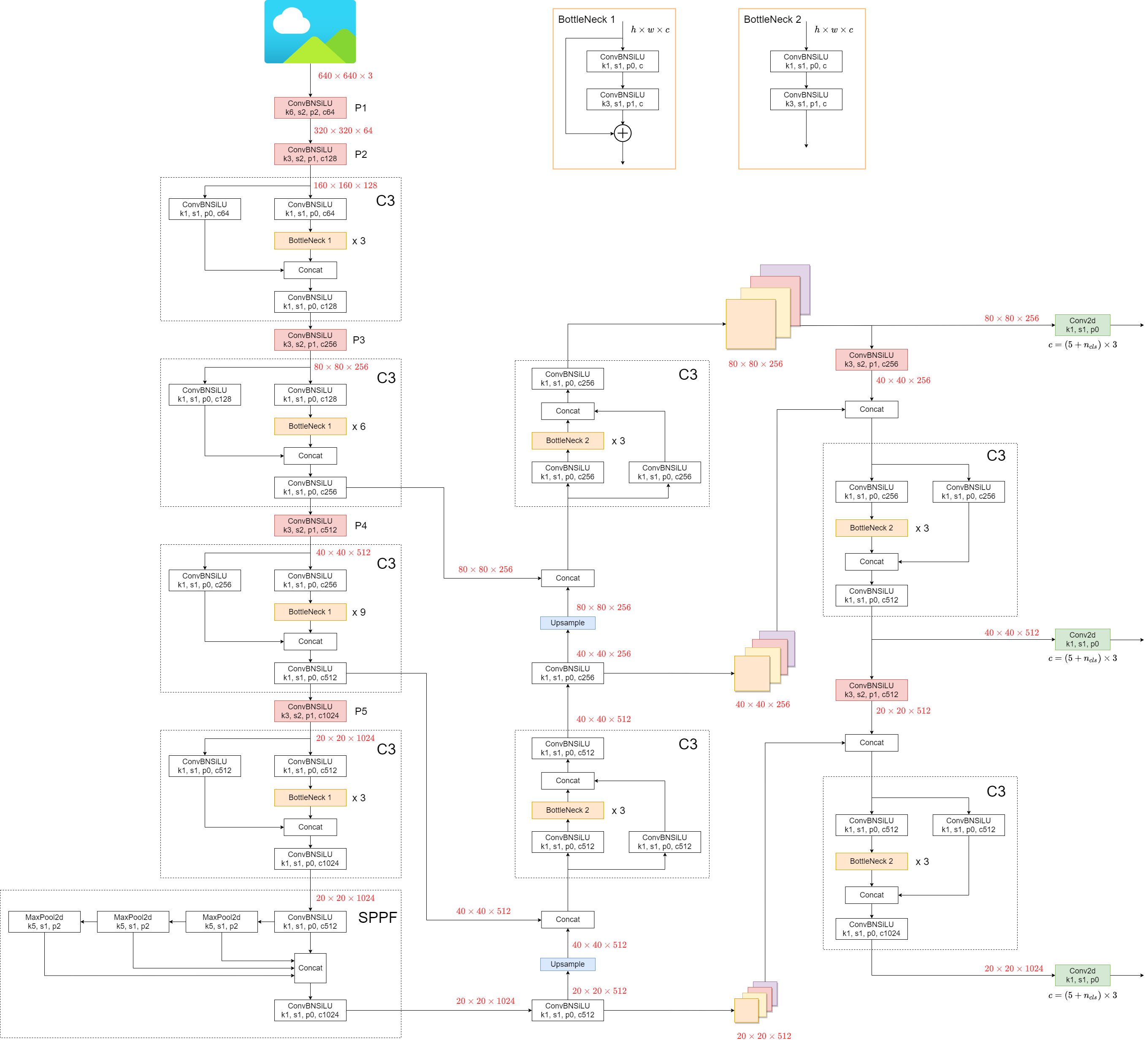6.7 KiB
| comments | description |
|---|---|
| true | Ultralytics YOLOv5 Docs: Learn model structure, data augmentation & training strategies. Build targets and the losses of object detection. |
1. Model Structure
YOLOv5 (v6.0/6.1) consists of:
- Backbone:
New CSP-Darknet53 - Neck:
SPPF,New CSP-PAN - Head:
YOLOv3 Head
Model structure (yolov5l.yaml):
Some minor changes compared to previous versions:
- Replace the
Focusstructure with6x6 Conv2d(more efficient, refer #4825) - Replace the
SPPstructure withSPPF(more than double the speed)
test code
import time
import torch
import torch.nn as nn
class SPP(nn.Module):
def __init__(self):
super().__init__()
self.maxpool1 = nn.MaxPool2d(5, 1, padding=2)
self.maxpool2 = nn.MaxPool2d(9, 1, padding=4)
self.maxpool3 = nn.MaxPool2d(13, 1, padding=6)
def forward(self, x):
o1 = self.maxpool1(x)
o2 = self.maxpool2(x)
o3 = self.maxpool3(x)
return torch.cat([x, o1, o2, o3], dim=1)
class SPPF(nn.Module):
def __init__(self):
super().__init__()
self.maxpool = nn.MaxPool2d(5, 1, padding=2)
def forward(self, x):
o1 = self.maxpool(x)
o2 = self.maxpool(o1)
o3 = self.maxpool(o2)
return torch.cat([x, o1, o2, o3], dim=1)
def main():
input_tensor = torch.rand(8, 32, 16, 16)
spp = SPP()
sppf = SPPF()
output1 = spp(input_tensor)
output2 = sppf(input_tensor)
print(torch.equal(output1, output2))
t_start = time.time()
for _ in range(100):
spp(input_tensor)
print(f"spp time: {time.time() - t_start}")
t_start = time.time()
for _ in range(100):
sppf(input_tensor)
print(f"sppf time: {time.time() - t_start}")
if __name__ == '__main__':
main()
result:
True
spp time: 0.5373051166534424
sppf time: 0.20780706405639648
2. Data Augmentation
-
Mosaic

-
Copy paste

-
Random affine(Rotation, Scale, Translation and Shear)

-
MixUp

-
Albumentations
-
Augment HSV(Hue, Saturation, Value)

-
Random horizontal flip

3. Training Strategies
- Multi-scale training(0.5~1.5x)
- AutoAnchor(For training custom data)
- Warmup and Cosine LR scheduler
- EMA(Exponential Moving Average)
- Mixed precision
- Evolve hyper-parameters
4. Others
4.1 Compute Losses
The YOLOv5 loss consists of three parts:
- Classes loss(BCE loss)
- Objectness loss(BCE loss)
- Location loss(CIoU loss)
4.2 Balance Losses
The objectness losses of the three prediction layers(P3, P4, P5) are weighted differently. The balance weights are [4.0, 1.0, 0.4] respectively.
4.3 Eliminate Grid Sensitivity
In YOLOv2 and YOLOv3, the formula for calculating the predicted target information is:

In YOLOv5, the formula is:
Compare the center point offset before and after scaling. The center point offset range is adjusted from (0, 1) to (-0.5, 1.5). Therefore, offset can easily get 0 or 1.

Compare the height and width scaling ratio(relative to anchor) before and after adjustment. The original yolo/darknet box equations have a serious flaw. Width and Height are completely unbounded as they are simply out=exp(in), which is dangerous, as it can lead to runaway gradients, instabilities, NaN losses and ultimately a complete loss of training. refer this issue

4.4 Build Targets
Match positive samples:
- Calculate the aspect ratio of GT and Anchor Templates

- Assign the successfully matched Anchor Templates to the corresponding cells

- Because the center point offset range is adjusted from (0, 1) to (-0.5, 1.5). GT Box can be assigned to more anchors.

